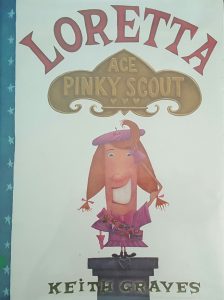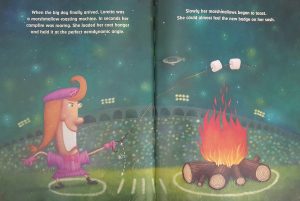

Title: Loretta Ace Pinky Scout
Author: Keith Graves
Illustrator: Keith Graves
Publishers and Year: Scholastic Press, 2002
Number of pages: 30
Genre: Fiction
Loretta Ace Pinky Scout is the story of a young girl who, due to pressures of living in a perfect family, aspires to perfection herself. It tells the story of her attempt and failure at winning a marshmallow-roasting badge. This failure sends her into a spiral with the realization that she is not perfect after all. A visit from the spirit of her grandmother reveals the imperfections in all of the people she viewed as perfect, allowing Loretta to see that it is okay to have flaws.
This book functions as a mirror to its readers. All people, adults and children alike, compare themselves to others at times or strive, sometimes without knowing it, for perfection in one area or another. This book allows children to see the benefits of imperfections and flaws in Loretta and her family with the intent of allowing them to come to terms with their own limitations and flaws in a healthy manner.
The dynamic of power is interesting in this story in that Loretta is portrayed by the illustrator as very small compared to most objects (i.e. World-dominating chicken, scout book, etc.). This shows the readers a lack of power, despite the fact that the words are emphasizing her power. I think that is important because all of this takes places before she realizes the beauty in her flaws. The only time she is shown as large is the very last page. On this page she is receiving a medal for saving the world. I think that this shift in power is crucial in allowing the reader to see that that he or she is only truly powerful when they accept themselves as they are rather than trying to be a perfected version of themselves.
The images in this story do a fantastic job of showcasing Loretta’s accomplishments in a way that add to the image of perfection. The readers are visually overwhelmed with her deeds and character, heartbroken with her over her failure, and able to champion her well in her new found identity as an imperfect but powerful human. In addition to the images playing a major role in the story, there are strategically placed thought bubbles that give us greater clues to Loretta’s thought process. I think this was an intentional and genius decision of the illustrator that really helps to move the book along. Overall, this book addresses an important self-worth issue among children: Perfection is a fake ideology. This shatters the glass on perfectionism, and thankfully so. Hopefully children will be able to read this and realize that, like Loretta, they do not need to be perfect to be accepted or even good.
